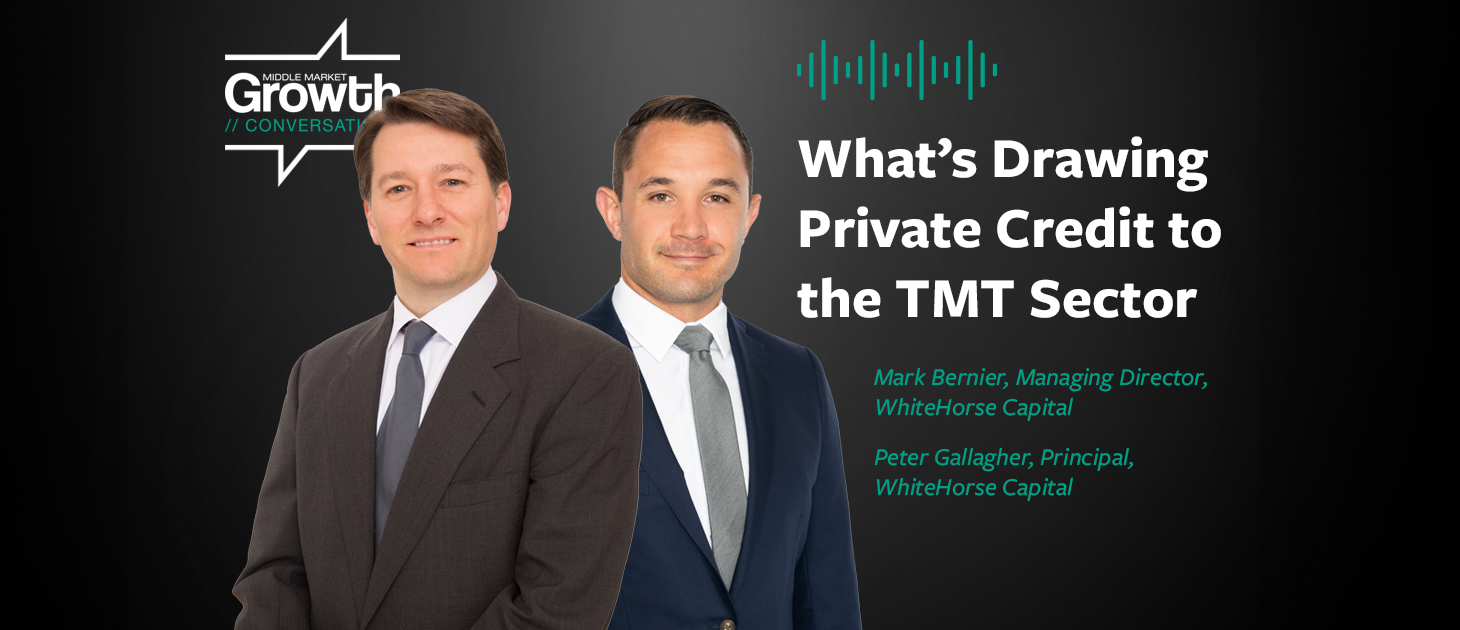What’s Drawing Private Credit to the TMT Sector
WhiteHorse Capital's Mark Bernier and Peter Gallagher join the Conversations podcast to share insights into private credit trends in the TMT sector

The outlook for the technology, media and telecom (TMT) sector is bright—and, the experts at WhiteHorse Capital say, full of opportunity for investors. Mark Bernier, WhiteHorse Capital’s managing director, and Peter Gallagher, principal, join the podcast to share their insights into today’s private credit market, trends in the TMT sector, how annual recurring revenue financing is evolving and more.
This episode is brought to you by WhiteHorse Capital. To learn more about WhiteHorse, visit whitehorse.com. Read a transcript of the podcast below. This transcript was prepared by a transcription service. This version may not be in its final form and may be updated.
Middle Market Growth: Welcome to the Middle Market Growth Conversations podcast, I’m Katie Maloney. Today we’re sitting down with WhiteHorse Capital’s managing director, Mark Bernier, and Peter Gallagher, principal at WhiteHorse. These two are joining me for a conversation about the current private credit market, with a focus on the technology, media and telecom space. Mark and Peter, welcome to the podcast.
Mark Bernier: Thanks, Katie.
MMG: So Mark, to start us off at a high level, can you talk about the state of the private credit market today and some of the trends that you’re seeing?
MB: Absolutely. So as we think about the current market, it’s helpful to think about the years leading up to it and how the pendulum has swung over the last 12 months from lender-friendly to borrower-friendly markets. Back in 2021, coming out of COVID, we had very aggressive credit markets, which were propelled by expansionary monetary and fiscal policies. And then in March 2022, the Fed started to raise rates, in the attempt to tame inflation. As we saw interest rates continuing to rise through 2023 and with fears of a potential recession or slowdown, the market shifted to a more lender-friendly market and within context of M&A dropping by about 40%. Now if we look at today and really late 2023 into 2024, with the expectations of the Fed starting to ease here in the near term, M&A and refinances have picked up. There was a lot of capital on the sidelines in the private credit market that was ready to put to work. So that pendulum has now swung to be in the favor of the borrower. In particular, over the last two quarters, we’ve seen the markets even get more aggressive. While M&A has picked up a bit, it’s still very sluggish, not at levels we’ve seen prior. And because of that, with people still needing to put money to work and have plenty of capital to put to work, not only in the private credit space, but also in the syndicated bank market, we’ve seen terms very much loosening. That includes also tighter pricing, higher leverage and typically smaller equity checks from sponsors.
If we look at today’s market, we think that pricing has stabilized around 500 to 550 basis points for most of the sponsor deals we’ve seen. For the upper middle market and large cap, we’ve seen prices even down to 450. We spend most of our time in the middle market space and I’d say kind of where we see the most opportunities today. But overall, if you compare where spreads are today versus say 12 months ago, they are at least 100 to 150 basis points lower. One final comment: We also have a robust non-sponsor origination platform. Those deals price at a premium to the sponsor market and we’re seeing good opportunity there. So, in addition to pure structural items such as leverage and pricing, we’ve seen increasingly aggressive documentation, which I think we’ll probably touch upon a little bit later in the podcast here.
Peter Gallagher: Thanks Mark. I think one point that I think is worth calling out as we think about the environment that we’re in today and contrasting it to the aggressive 2021 period, one major difference is that interest rates are still extremely elevated today. LIBOR was sub-1% in 2021, and SOFR remains in excess of 5% today. So understanding that the Fed has recently signaled they’ll begin reducing rates, I think there’s a good chance that rates remain above 2021 levels for some time. So while we’re seeing leverage multiples increase, LTVs increase, which you could say are similar to the levels that would have been contemplated for similar businesses in 2021, interest coverage ratios and fixed charge coverage ratios are still materially lower today than where we would have seen them a few years ago. And I think what that means for us as lenders, as we underwrite new opportunities, is there’s significantly less margin for error or cushion for underperformance at our borrowers.
MMG: Great, thank you both for that info and helping to set the stage for our conversation here. In an interview with your WhiteHorse colleagues a few months ago, we talked about structuring a team around industry verticals and the advantages and disadvantages of that for due diligence. Mark, would you mind giving a refresher on how WhiteHorse approaches sector coverage and the benefits for origination that come with having teams devoted to specific verticals?
MB: Happy to. In general, WhiteHorse is an industry-agnostic firm covering all the major industry sectors, with the exception of kind of the sectors that are not ESG compliant. But what differentiates ourselves a bit is we do maintain specific vertical expertise in sectors such as TMT, healthcare and logistics. TMT is our largest industry vertical which represents roughly 25% of our current deployed portfolio. Now, having said that, within that 25% there is significant diversification across or within the TMT segment, such as software, telecom, IT services, digital marketing and such. I have a TMT team that leads the majority of our TMT underwriting and portfolio management in that segment. I’ve personally been investing in the space for almost 30 years, and I also sit on WhiteHorse’s investment committee, so I get to see and opine on all the deals that go through our deal funnel. Pete has over 12 years of TMT experience and is a senior leader within the team as well. So having a 100% focused TMT credit team allows us to be more efficient in evaluating opportunities while also being strong partners to owners and buyers of TMT companies.
Moving to the origination side, we have over 20 generalist senior originators who are spread across the U.S. in major cities, covering sponsors, investment banks, advisors, lawyers and management teams. And while 70% of our deal opportunities come from sponsors, we also have a robust calling effort in the non-sponsor space. Particularly in TMT, the non-sponsor space provides us with attractive opportunities as there are still lots of sizeable companies that are not sponsor-owned, private and public. So, in terms of the benefits of having vertical teams, from the perspective of WhiteHorse, it really comes down to two big themes. Number one, it allows us to make informed decisions more quickly and provide higher quality initial feedback to sponsors who are involved in fast-moving processes. Sponsors very much appreciate that. And number two, it also allows us to be better partners not only to our portfolio companies but also to our front-end originators who are sourcing TMT deal flow—which, by the way, is the largest component of the leveraged loan market in the U.S. So, from our perspective, we find this is a really good competitive differentiation to our platform and allows us to be successful in the TMT space.
MMG: Peter, building on Mark’s comments, I would love to hear you talk a little bit about what attracts WhiteHorse to the TMT space and what you’re seeing as far as key attributes and risks across this sector.
PG: Absolutely. Well, the various subsectors within the TMT space exhibit kind of various credit characteristics. One of the reasons we’re attracted to TMT is most of the businesses we look at within the space have a number of attractive credit qualities, which include a high percentage of recurring revenue, which in some cases are contractual under annual or multiyear contracts. You have attractive margin profiles with strong free cash flow generation and strong enterprise value coverage through cycles. All of these qualities make these assets attractive, not only from a debt perspective, but also an equity perspective. Another reason we like the space is that there’s generally a strong interest from PE investors in the TMT segment, as well as ample non-sponsor opportunities. And to your second point, from a risk perspective, there’s a number of areas where we’re typically diligencing on these deals and that includes customer retention and churn metrics, including understanding product stickiness and customer switching costs. We look at competition, regulatory risks and risks associated with certain technology changes or advancements. This is one area we’ve been spending more time on recently given the quickly evolving AI landscape and really digging in to understand how AI applications can or will impact our end markets and the businesses we’re looking at. Now, every deal we underwrite will obviously have deal-specific risks that we need to assess and underwrite, but having the vertical expertise puts us in a position to not only assess new deals efficiently, but given the volume of deals we look at coupled with the team consistency, we have a deep comp set that we can leverage when we’re looking at new opportunities. Really, our goal is to know as much about the credit as our borrower or owners know so that we can not only appropriately assess the risks but ensure that we’re in a position to be strong partners in both good times and bad.
MMG: Great. And Mark, is there anything you’d add there as far as trends that you’re seeing within the TMT space?
MB: One of the sectors that has been particularly active is the IT services space. And that’s a pretty broad category, but it would generally include digital engineering services, MSPs or managed service providers, system integrators, folks like that. We’ve seen lots of sponsors and, frankly, non-sponsored opportunities in this segment and have a number of portfolio companies. It’s interesting, in that space we saw very meaningful revenue and EBITDA growth coming out of COVID, which is no surprise. There was significant pull forward and demand from customers that wanted to accelerate their digital transformation or accelerate their digital transformation roadmaps. But interestingly over the last I’d say 12 months, six to 12 months, we’ve seen a general slowdown in customer spend and perhaps a bit more reserve in spending and their budgeting. I’d say while in certain pockets, most pockets were still seeing year-over-year growth. The growth rates have meaningfully declined. Where they were easily double digit coming out of COVID, now they’re single to perhaps flat on a revenue basis. We still really like the segment even under this kind of lower growth or flattish environment. These companies candidly generate meaningful free-cash flow and are attractive candidates to sponsors. And there are significant tailwinds still with these companies as they support their clients to invest in their digital infrastructure. We’ll look at pretty much every segment within TMT and including one segment that tends to be a little bit out of favor and has been out of favor, which is traditional media. We’ve been active in that space. It’s less banked because of some of the headwinds on the revenue side. But these businesses still generate very strong free cash flow and so at the right leverage levels, there are deals to be done there, and we have a couple in our portfolio that are performing well. So, I’d say overall we know that the TMT industry is a very large, broad segment with lots of deal opportunities. And for us at WhiteHorse, it’s important to us to continue to differentiate ourselves from other lenders with our vertical expertise where sponsors and owners value partners that have a strong fundamental knowledge of their business.
MMG: And within TMT, Peter, can you touch on annual recurring revenue financings and whether this is an area that WhiteHorse participates in today, given that these ARR structures are relatively unique?
PG: Absolutely. So, the ARR financing markets is an area we are active in. A couple of years ago, our team built out a formal strategy and approach to underwriting these deals and we’ve been very disciplined in sticking to our strategy. Our fundamental thesis when it comes to ARR facilities is that these are intended for businesses that have the ability to generate positive free cash flow but have chosen to prioritize growth over profitability by investing in sales and marketing, R&D and other customer acquisition activities. Additionally, we think that these businesses should exhibit relatively specific credit characteristics that weren’t an ARR structure. So, borrowers should have sticky customer relationships through contractual or subscription-based revenues, strong customer retention metrics or low customer churn, strong gross margins, and they should be non-cyclical or recession-resilient businesses. Consistent with Mark’s comments earlier about the general private credit environment in 2021, the ARR financing market in particular was an area where we saw lenders getting extremely aggressive. During that period, a number of ARR opportunities were pitched to us that did not, at least in our minds, warrant ARR treatment, meaning we were seeing recurring revenue loans pitched for businesses that didn’t have truly contractual or subscription-based revenue or recurring revenue streams. Instead, the majority of the company’s revenues were coming from reoccurring or in some cases project-based revenue streams. We chose to pass on these opportunities during that period. And moving into 2022 and 2023, we saw a meaningful pullback in the number of ARR deals getting done in the market and saw structures start to tighten meaningfully. Where we sit today, while we’re seeing the broader private credit market become more aggressive as we progress kind of through 2024, from what we’ve seen thus far, there’s been significantly less deal volume on the ARR side relative to what we saw in the 2021 timeframe. And we think this is largely a function of the elevated rate environment, pressuring cash flows as well as moderating the growth rates Mark alluded to that we’ve been seeing broadly across the tech and software space which makes these deals more difficult to structure and underwrite.
MMG: Switching back to the broader private credit market, this year the market has been characterized as extremely competitive with loosening structures and documentation terms like you both have alluded to. So, Mark, can you talk about how you stay competitive in an environment like this while also balancing credit risk?
MB: Yeah, absolutely. Let me first touch upon the overall WhiteHorse platform. Our total AUM, assets under management, has grown to over $13 billion with investable assets of $8 billion. So, we have plenty of dry powder to support new deals. We currently have the ability to underwrite up to $300 million and hold up to $200 million on individual transactions, illustrating our breadth of our capital base. Now, having said that, we are still open to doing smaller deals. Our minimum check size is $30 million, so while we like the larger deals, we’re very much open to business to doing the smaller deals in smaller companies as well. As we mentioned, we’re industry agnostic but with our expertise in certain verticals, it helps us to differentiate ourselves. And while we do like clean credits, like everybody else, we also don’t shy away from complexity. So, circling back, what’s important from the WhiteHorse perspective and how we compete in this market, we really leverage our 20 person plus originator platform who are in local markets uncovering good sponsor and non-sponsor opportunities for us. Now, our credit culture is a disciplined one. We will lean in on credits that we like, whether leverage or price, but we will be very careful and, in many cases, turn down deals that have certain credit flaws. We have long dated relationships with middle market sponsors across the firm and that allows us to partner with buyers who have supported their deals during tough times. We love those relationships. Particularly in this market, we know that we’re leaning in on deals to win. These are the types of partnerships we manage very actively within our platform. And in addition, during hot markets that we’re in, we double down on the lower middle market sponsor and non-sponsor segments. We think those segments to be less competitive with less players. And again, having the benefit of our broad origination team in our local markets, they can drum up really good opportunities for us that give us an opportunity to put forth and close good deals. I’ve been around long enough to understand and to experience that lending markets have cycles, sometimes mini cycles, sometimes big cycles. At WhiteHorse, we just try to be consistent and thoughtful while understanding that credit standards, whether tightening or loosening, need to be altered at times in ways that allow us to deploy capital prudently over time.
MMG: Finally, to close us out, as lenders get aggressive to win new deals, like you just mentioned, Mark, and we start to see credit documents becoming more borrower-friendly, can you each discuss key structural or documentation items that you typically look to include in your TMT deals, maybe starting with you, Peter?
PG: Sure. So maybe just to kick things off, one thing to highlight is we’ve recently been seeing kind of smaller and smaller deals going cov-lite. While we will pursue cov-lite deals, it’s typically on a limited basis and typically reserved for larger and stronger credits. So, this is another area where we’ve remained fairly disciplined and have not been stretching in these situations. And when we think about covenants and sticking with the topic of elevated interest rates, one area we remain highly focused on is the financial covenant levels themselves and the implied EBITDA cushions based on those levels. So, in the past, typically when you saw a covenant default, if structured appropriately, in most situations, the business would like still to be generating positive leverage-free cash flow. So, you’re in a situation where you’re back at the table with the sponsor or company before liquidity or the ability to service debt is an immediate problem. But again, given the interest environment that we’re in today, if a company is breaching their leverage covenant there may be little to no leverage-free cash flow. And depending on where your covenant levels were set from the onset, there are situations when we run our sensitivity cases that you see the company is going to run into liquidity issues and a payment default well before actually tripping a leverage covenant which makes things very difficult in a downside scenario. Ideally, we want to be back at the table well before liquidity becomes an issue. And lastly, we’re highly focused on the negative covenant baskets and specifically looking to tighten areas of potential leakage. So, in addition to looking at restricted payment capacity within the documents, we’re focused on the ability for non-loan parties or unrestricted subsidiaries to incur debt or the ability for the borrower to make investments in non-loan parties or unrestricted subs.
MB: Just to perhaps put a finer point on that, we’ve seen lots of press on what you call liability management exercises, LMEs, sometimes they’re called liability management transactions, LMTs. And that’s why, really, negative covenants in the cushions and the baskets are super important to be focused on. These LMEs can take a number of forms, including up-tier transactions, drop-downs and now double-dips. But generally speaking, LMEs involve a combination essentially of shuffling assets, exchanging existing debt and raising fresh senior priority debt. The more wide open the documents are for asset transfers and drop-downs, the higher risk of an LME transaction. Over the past few years, lawyers have added technology and credit documents that candidly many lenders did not understand the downside of these changes and we are now seeing the effects of these changes as there have been roughly 30 LME transactions over the past 12 months or so. Clearly, normal J. Crew language did not truly mitigate LME risk. So, from the WhiteHorse perspective, for the vast majority of our deals, we are either the admin agent or co-lead. So, this LME risk is significantly curtailed or even completely mitigated. There are situations though we do go into more broadly syndicated deals or larger private club deals. And so, in those situations, we try to be more conservative in the documents, provide comments where we can to tighten up the documents to try to better manage LME risk going forward. This is a very small piece of our business, so it’s not one that we push frankly very often. And so, the LME risk that we see is much, much less. But having said that, an interesting dynamic we see out there occurring, and it’s an early trend, we’ll see if it kind of continues, but we are seeing other big lenders like us becoming more focused on this LME risk and actually seeing lender lawyers be successful adding these provisions and language that do not fully mitigate LME risk but make it a lot more difficult to do an LME transaction. Hopefully that trend continues, and we can tighten these documents up a bit more so that we don’t have this lender-on-lender violence as we’re seeing certainly in the last 12 months in the larger deals.
MMG: Great, we’ll close things out there. Mark and Peter, thank you so much for your time today to talk about the private credit markets and the TMT space in particular. I enjoyed the conversation and really appreciate you both joining us today.
MB: Thank you, Katie.
PG: Thank you.
The Middle Market Growth Conversations podcast is produced by the Association for Corporate Growth. To hear more interviews with middle-market influencers, subscribe to the Middle Market Growth Conversations podcast on Apple Podcasts, Spotify and Soundcloud.


